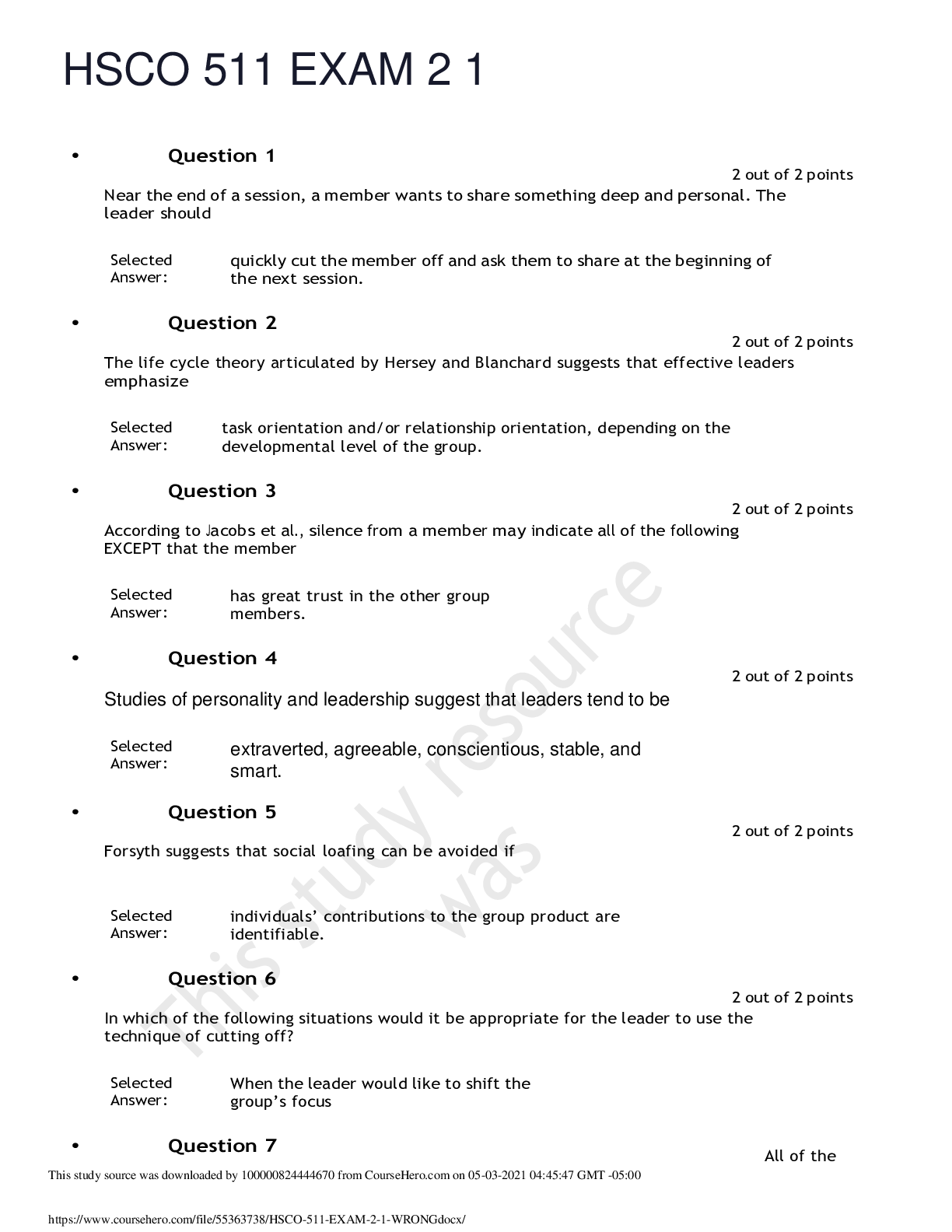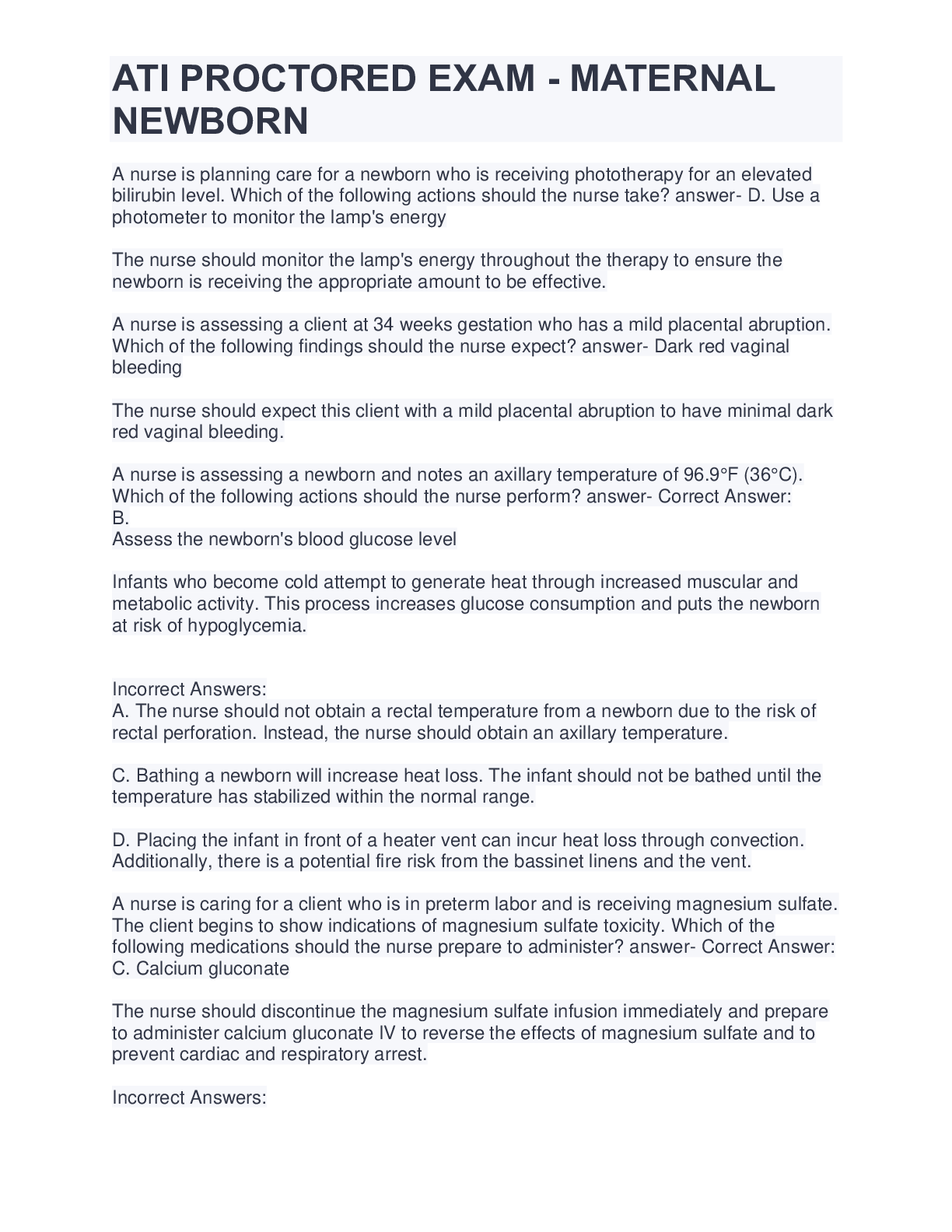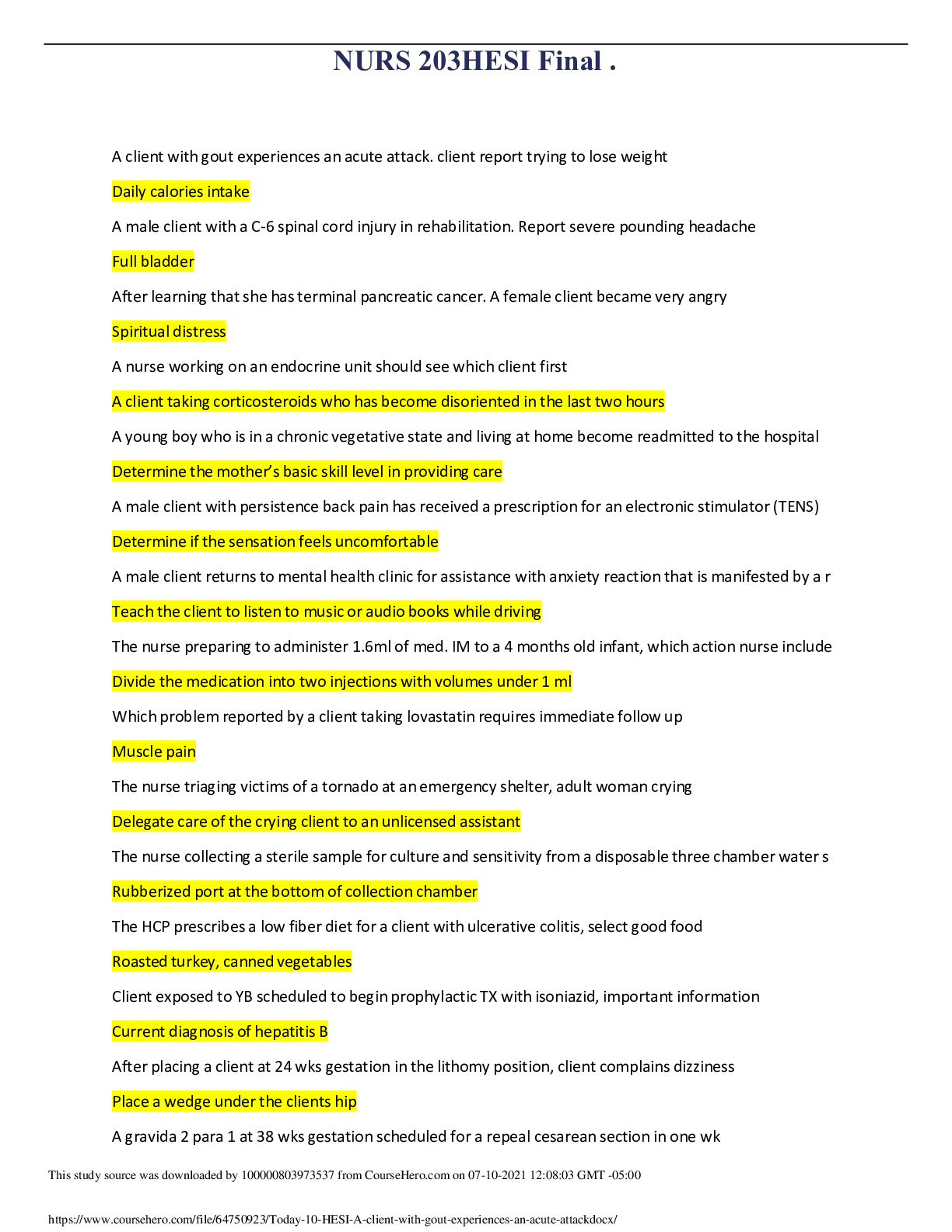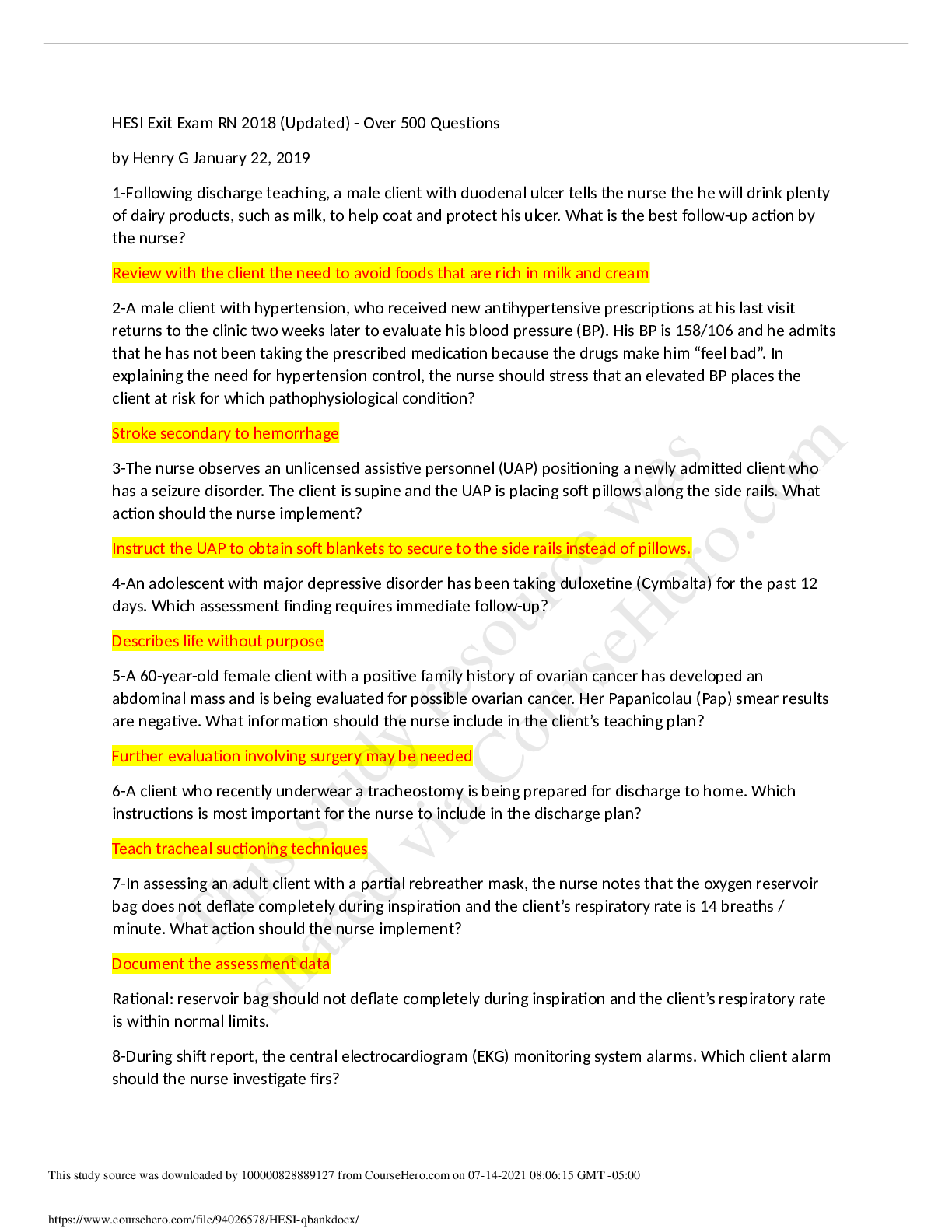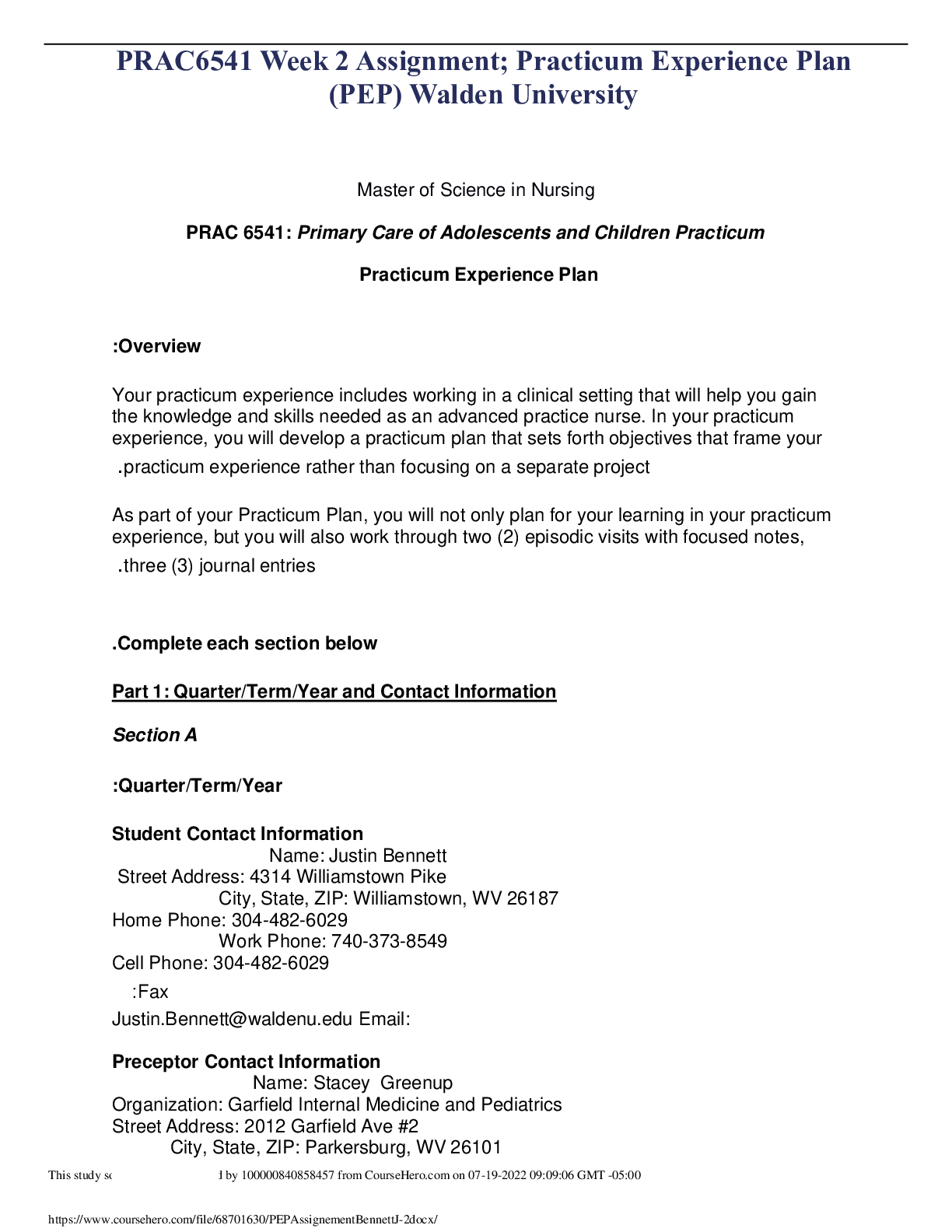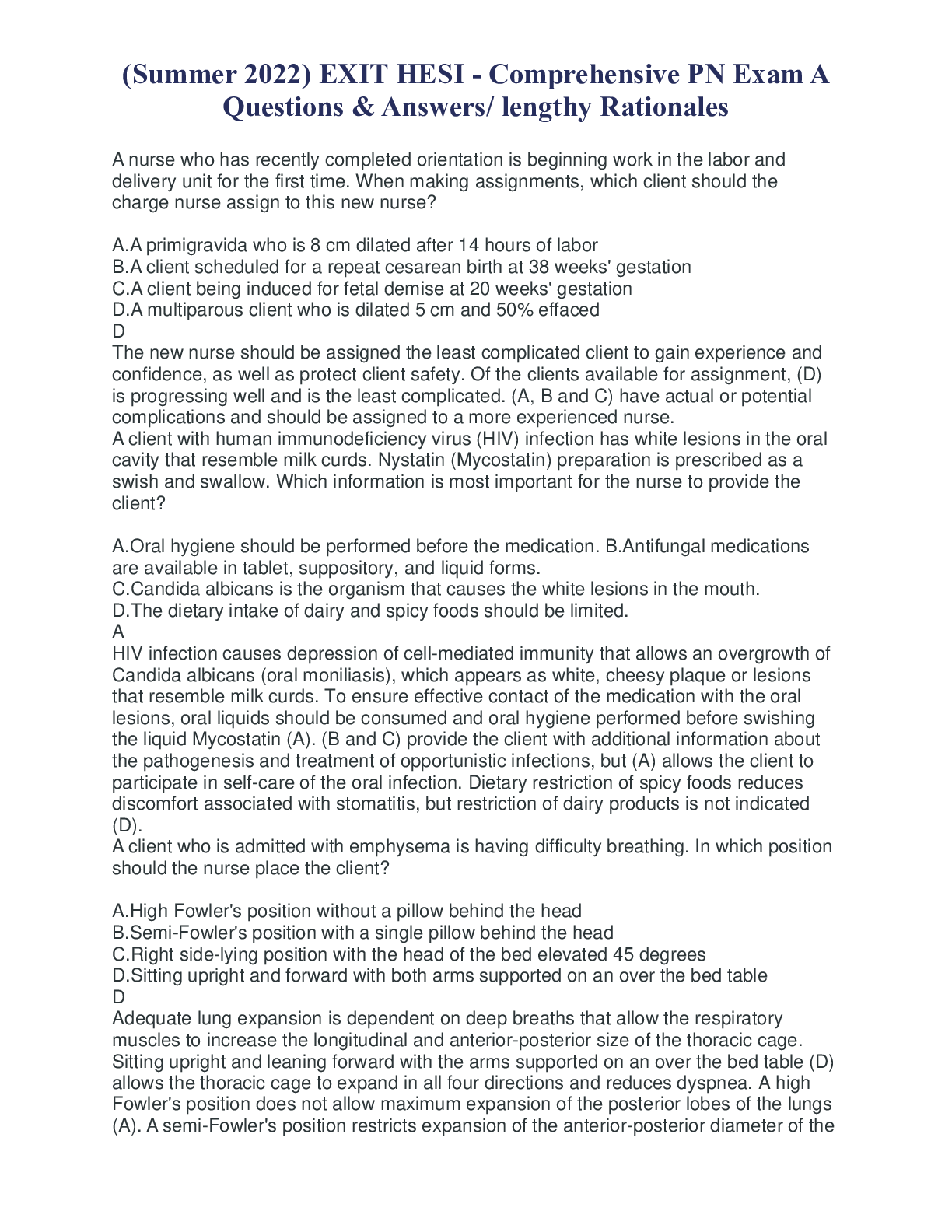Accounting > EXAM > ACCT 424 Midterm Exam ,LATEST GRADED A. (All)
ACCT 424 Midterm Exam ,LATEST GRADED A.
Document Content and Description Below
1. (TCO 2) For the current year, Kelly Corp. had net income per books of $300,000 before the provision for federal income taxes. Included in the net income were the following items: Dividend income f... rom an unaffiliated domestic taxable corporation (taxable income limitation does not apply and there is no portfolio indebtedness) $50,000. Bad debt expense (represents the increase in the allowance for doubtful accounts) $80,000. Assuming no bad debt was written off, what is Kelly’s taxable income for the current year? (Points : 5) $250,000 $330,000 $345,000 $380,000 Question 2. 2. (TCO 2) Which statement is incorrect with respect to the treatment of net operating losses by corporations? (Points : 5) A corporation may elect to forgo the carryback period, and just carry forward an NOL. A corporation may claim dividends received deduction in computing an NOL. An NOL is generally carried back 2 years and forward 20 years. Unlike individuals, corporations do not adjust their NOLs for net capital losses or nonbusiness deductions. None of the above Question 3. 3. (TCO 1) Ilene and Frank form Happy Corporation. Ilene transfers equipment worth $475,000 (basis of $100,000) and $25,000 cash to Happy Corporation for 50% of its stock. Frank transfers a building and land worth $525,000 (basis of $200,000) for 50% of Happy’s stock and $25,000 cash. Discuss the result of these transfers. (Points : 5) Ilene recognizes a gain of $375,000; Frank recognizes a gain of $325,000. Ilene recognizes a gain of $25,000; Frank recognizes no gain. Neither Ilene nor Frank recognizes gain. Ilene recognizes no gain; Frank recognizes a gain of $25,000. None of the above Question 4. 4. (TCO 1) Sandy Corporation owns 10% of the stock of Fran Corporation, which pays it a dividend of $100,000. Sandy Corporation also owns 80% of the stock of Sammy Corporation, which pays it a $25,000 dividend. Assuming the taxable income limitation does not apply, how much is Sandy Corporation’s dividend received deduction for the year? (Points : 5) $87,500 $95,000 $125,000 None of the above Question 5. 5. (TCO 1) George operates a retail business selling illegal narcotic substances. Which of the following item(s) may George deduct in calculating business income? (I). Cost of merchandise. (II). Business expenses other than the cost of merchandise. (Points : 5) I only. II only. Both I and II. Neither I nor II. Question 6. 6. (TCO 11) Freddy, a calendar-year taxpayer subject to a 35% marginal tax rate, claimed a charitable contribution deduction of $18,000 for a sculpture that the IRS later valued at $10,000. Which is the applicable overvaluation penalty? (Points : 5) $0 $560 $2,800 $3,500 Question 7. 7. (TCO 11) In which of the following circumstances does the 3-year statute of limitations on additional tax assessments apply? (Points : 5) A taxpayer willfully attempts to evade tax in filing income tax returns. A taxpayer inadvertently omits from gross income an amount in excess of 25% of the gross income stated on the income tax return. A taxpayer inadvertently overstates deductions equal to 15% of gross income. The IRS files a substitute income tax return when it learns that a taxpayer failed to file a return. Question 8. 8. (TCO 2) Grace Corporation manufactures and sells ceramic dinnerware. The company also sells dinnerware that is purchased from unrelated foreign producers. During tax year, Grace Corporation had a U.S. profit of $1.2 million (QPAI), and a loss from the imported merchandise of $100,000. Which is Grace’s DPAD? (Points : 5) $0 $33,000 $66,000 $99,000 None of the above Question 9. 9. (TCO 2) Kent Corp. is a calendar-year accrual basis C corporation. In Year 1, Kent made a nonliquidating distribution of property with an adjusted basis of $150,000 and a fair market value of $200,000 to Reed, its sole shareholder. The following information pertains to Kent. Reed’s basis in Kent stock at January 1, Year 1 $500,000 Accumulated earnings and profits at January 1, Year 1 $125,000. Current earnings and profits for Year 1 (from operations) $60,000. What was taxable as dividend income to Reed for Year 1? (Points : 5) $60,000 $150,000 $185,000 $200,000 Question 10. 10. (TCO 3) As of January 1, Boulder Corporation has a deficit in accumulated E & P of $37,500. For the tax year, current E & P (all of which accrued ratably) is $20,000 (prior to any distribution). On July 1, Boulder Corporation distributes $25,000 to its sole, noncorporate shareholder. The amount of the distribution that is a dividend is _____. (Points : 5) $0 $20,000 $25,000 $37,500 None of the above Question 11. 11. (TCO 3) Jeffrey Corporation has accumulated E & P of $30,000 on January 1. During the year, the corporation distributes $120,000 to its sole shareholder, Abe (an individual). Jeffrey Corporation’s E & P as of January 1 of the following year is _____. (Points : 5) $0 ($35,000) $40,000 $85,000 None of the above Question 12. 12. (TCO 3) Which statement about property distributions is false? (Points : 5) When the basis of distributed property is greater than its fair market value, a deficit may be created in E & P. When the basis of distributed property is less than its fair market value, the distributing corporation recognizes gain. When the basis of distributed property is greater than its fair market value, the distributing corporation does not recognize loss. The amount of a distribution received by a shareholder is measured by using the property’s fair market value. All of the above Question 13. 13. (TCO 4) Five years ago, Reba transferred property she had used in her sole proprietorship to Green Corporation for 1,000 shares of Green Corporation in a transaction that qualified under § 351. The assets had a tax basis to her of $100,000, and a fair market value of $270,000 on the date of the transfer. In the current year, Green Corporation (E&P $800,000) redeems 250 shares from Reba for $220,000 in a transaction that qualifies for sale or exchange treatment. With respect to the redemption, Reba will have a _____. (Points : 5) $195,000 capital gain $220,000 capital gain $195,000 dividend $220,000 dividend None of the above Question 14. 14. (TCO 4) Cook Corporation has 1,000 shares of stock outstanding. Harold owns 250 shares, Harold’s father owns 150 shares, Harold’s brother owns 250 shares, and Harold’s son owns 50 shares. Blue Corporation owns the other 300 shares in Cook Corporation. Harold owns 60% of the stock in Blue Corporation. Applying the § 318 stock attribution rules, how many shares does Harold own in Cook Corporation? (Points : 5) 250 400 450 630 None of the above Question 15. 15. (TCO 5) One of the tenets of U.S. tax policy is to encourage business development. Which Code section does not support this tenet? (Points : 5) § 351, which allows entities to incorporate tax-free § 1031, which allows the exchange of stock of one corporation for stock of another § 368, which allows for tax-favorable corporate restructuring through mergers and acquisitions § 381, which allows the target corporation’s tax benefits to carry over to the successor corporation All of the above Question 16. 16. (TCO 5) Thomas Corporation has assets worth $700,000 (adjusted basis of $315,000). Smiles Corporation would like to acquire all of Thomas’s assets in a Type C reorganization in exchange for $450,000 of voting stock, $125,000 cash, and assumption of Thomas’s liabilities of $125,000. All stock received by Thomas will be distributed to its shareholders, and Thomas will then liquidate. Which, if any, statement regarding this transaction is correct? (Points : 5) Thomas will realize a gain of $385,000, and recognize a gain of $0. Thomas will realize a gain of $385,000, and recognize a gain of $125,000. Thomas will realize a gain of $385,000, and recognize a gain of $150,000. Thomas will realize a gain of $385,000, and recognize a gain of $385,000. None of the above Question 17. 17. (TCO 5) In which type of divisive corporate reorganization do the shareholders receive stock in another corporation without relinquishing any of their stock in the original corporation? (Points : 5) Type A consolidation reorganization Reverse Type B reorganization Type D split-off reorganization Type D split-up reorganization Type D spin-off reorganization. Question 18. 18. (TCO 6) X, Y, and Z Corporations file Federal tax returns on a consolidated basis. The group’s tax return has been under audit. Under a valid tax-sharing agreement, each corporation is liable for one-third of the group’s consolidated tax liability. The parties have agreed that the group’s unpaid liability for the year is $220,000. Because of an incorrect tax return position, $120,000 interest and a $90,000 penalty is attributable to X. At present, only Y is solvent and has the cash with which to make such a substantial tax payment. What is the maximum amount for which the IRS could be successful in forcing Y to satisfy the outstanding liabilities of the consolidated group? (Points : 5) $430,000. $220,000. $107,500. $30,000. Some other amount Question 19. 19. (TCO 6) ParentCo’s separate taxable income was $350,000, and SubCo’s was $225,000. Consolidated taxable income before contributions was $400,000. Charitable contributions made by the affiliated group included $15,000 by ParentCo, and $20,000 by SubCo. Compute the group’s charitable contribution deduction. (Points : 5) $57,500 $40,000 $35,000 $0 None of the above Question 20. 20. (TCO 6) George, Joseph, and Roz constitute an affiliated group of corporations. Which tax effect becomes more restrictive if an election is made to file on a consolidated basis? (Points : 5) Choice of members’ tax accounting methods Use of the lower tax rate brackets Use of the $40,000 AMT exemption Choice of members’ tax year-ends 1. (TCO 2) Tate Company has approximately $250,000 in net income before deducting any compensation or other payment to its sole owner, Shari (who is single). Assume that Shari is in the 35% marginal tax bracket. Discuss the tax aspects of each of the following arrangements. (Ignore any employment tax considerations.) (I) Shari operates Tate Company as a proprietorship. (II) Shari incorporates Tate Company and pays herself a salary of $150,000 and no dividend. (III) Shari incorporates the company and pays herself a $150,000 salary and a dividend of $77,750 ($100,000 – $22,250 corporate income tax). (IV) Shari incorporates the company and pays herself a salary of $250,000. (Points : 20) I) a. Shari’s tax on $250,000 at 35% = $87500 II) Shari’s tax on $150,000 at 35% $52,500 tate’s tax on $100,000 at corporate rates $22,250 Total tax $74,750 III) tate’s tax on $100,000 at corporate rates$22,250 Shari’s tax on $77,750 dividend distributed at 15% $11,663 Shari’s tax on $150,000 salary at 35% $52,500 Total tax $86,413 IV) Shari’s tax on $250,000 at 35% = $87500 2. (TCO 11) Lisa, a CPA, feels that she cannot act as an aggressive advocate for tax clients in today’s environment. What aspects of the ethical conduct of a tax practice might have influenced Lisa’s attitude? (Points : 20) Lisa might be acting to the general increase in the regulation of the tax profession that has occurred in the last decade. Due to more aggressive pressure from congress to close the tax gap and public demands for transparency after the Enron and other reporting disaster, they have developed greater pro-government influences on the ethical conduct of a tax practitioner. These include some of the following items: 1) Increased disclosure standards to avoid preparer penalties (e.g taking unreasonable tax return positions). 2) Increased dollar amounts of certain preparer penalties. 3) Penalties assessed for the actions of appraisers, attorneys and other parties conceivably involved in a tax understatement. 4) Penalty assessed for any disallowed refund claim. 5) Limitations on the CPA/taxpayer confidentiality privilege. 3. (TCO 4) DLA Corporation has 1,000 shares of common stock outstanding. Mark owns 200 shares, Mark’s mother owns 200 shares, Mark’s daughter owns 100 shares, and Mark’s sister owns 150 shares. The remaining shares outstanding are owned by HNK Corporation (150 shares) and TMS Partnership (200 shares). Mark owns 60% of the stock in HNK Corporation. I) Mark owns 200 shares II) Mark owns 740 shares III) Mark owns 840 share 5. (TCO 6) In the context of a federal consolidated income tax return, describe the matching rule and the acceleration rule. The regulations apply these rules to some of the intercompany transactions of an affiliated group. (Points : 20) Gain or loss realized on property transactions between affiliates may not be recognized immediately. If more than one tax year is involved, the recognized gain or loss is deferred under matching rule until the sold asset leaves the affiliated group i.e. by a subsequent sale to a non-affiliated third party. This prevents group members from manipulating consolidated taxable income merely by moving assets among the members. The acceleration rule works with respect to a deferred gain or loss when one of the affiliates involved in the transaction leaves the group or if the consolidation election is terminated. At that time full gain or loss recognition is triggered. 4. (TCO 5) Prince Corporation is acquiring Jam Corporation in a Type A reorganization by exchanging 40% of its voting stock and $50,000 for all of Jam’s assets (value of $850,000 and basis of $600,000) and liabilities ($200,000). The shareholders of Jam are Susan (650 shares) and Richard (350 shares). They bought their stock for $500 per share. What is the amount of gains or losses that Susan and Richard will recognize due to the reorganization? What is the value of the stock they received from Prince and what is their basis in the Prince stock? (Points : 20) Susan $390,000 Prince stock; Richard $210,000 Prince stock. Susan has $32,500 recognized gain, Richard has $17,500 recognized gain. Susan’s basis in her Jam stock is $325,000 (650 ´ $500) and the value of her Jam stock is $422,500 [($850,000 – $200,000) ´ 65%]. She receives $32,500 in cash ($50,000 ´ 65%) and $390,000 in Prince stock [($850,000 – $200,000 – $50,000) ´ 65%]. Richard’s basis in his Jam stock is $175,000 (350 ´ $500) and the value of his Jam stock is $227,500 [($850,000 – $200,000) ´ 35%]. He receives $17,500 in cash ($50,000 ´ 35%) and $210,000 in Prince stock [($850,000 – $200,000 – $50,000) ´ 35%] [Show More]
Last updated: 1 year ago
Preview 1 out of 14 pages
.png)
Buy this document to get the full access instantly
Instant Download Access after purchase
Add to cartInstant download
We Accept:

Reviews( 0 )
$22.00
Document information
Connected school, study & course
About the document
Uploaded On
Apr 30, 2021
Number of pages
14
Written in
Additional information
This document has been written for:
Uploaded
Apr 30, 2021
Downloads
0
Views
50

